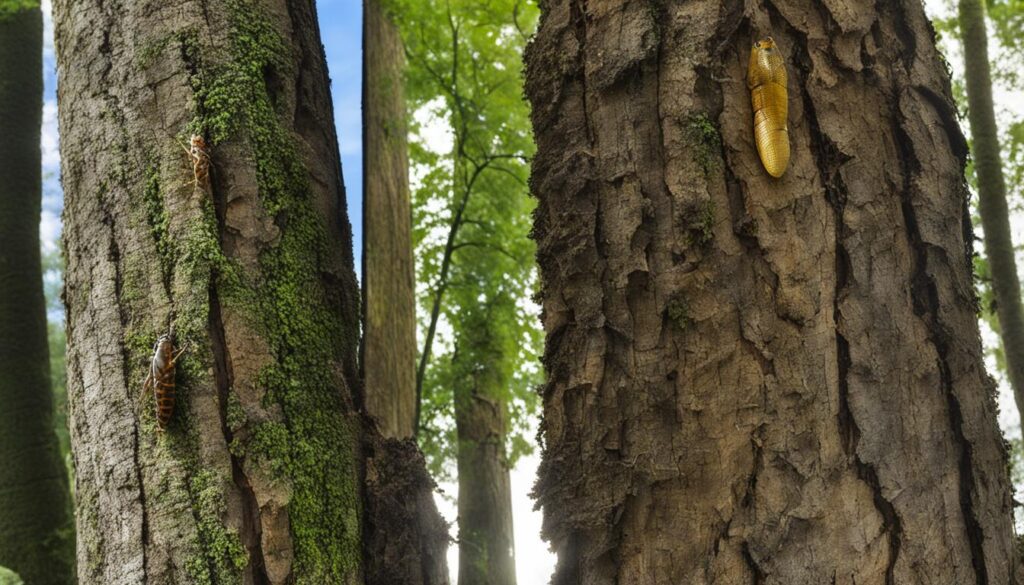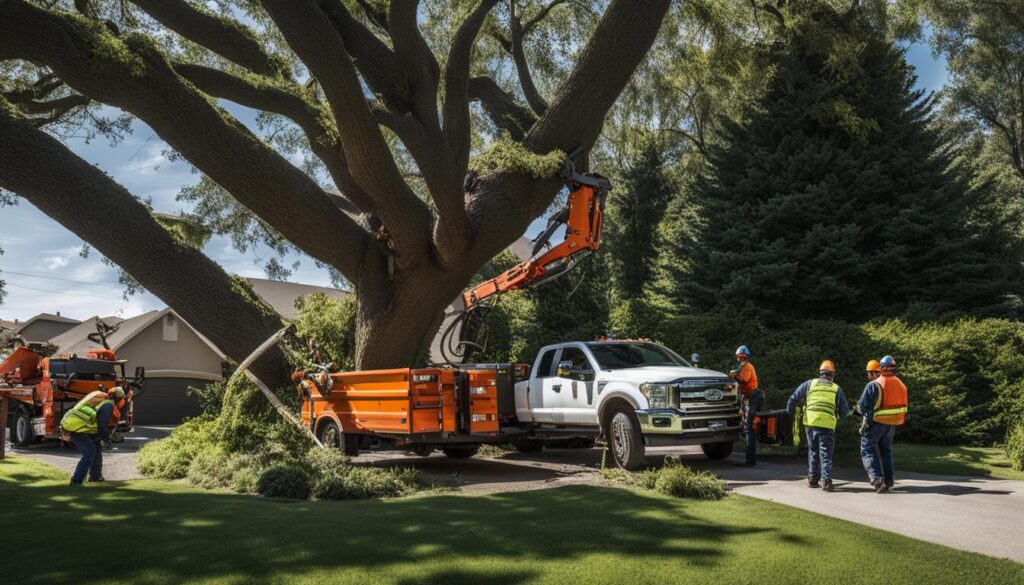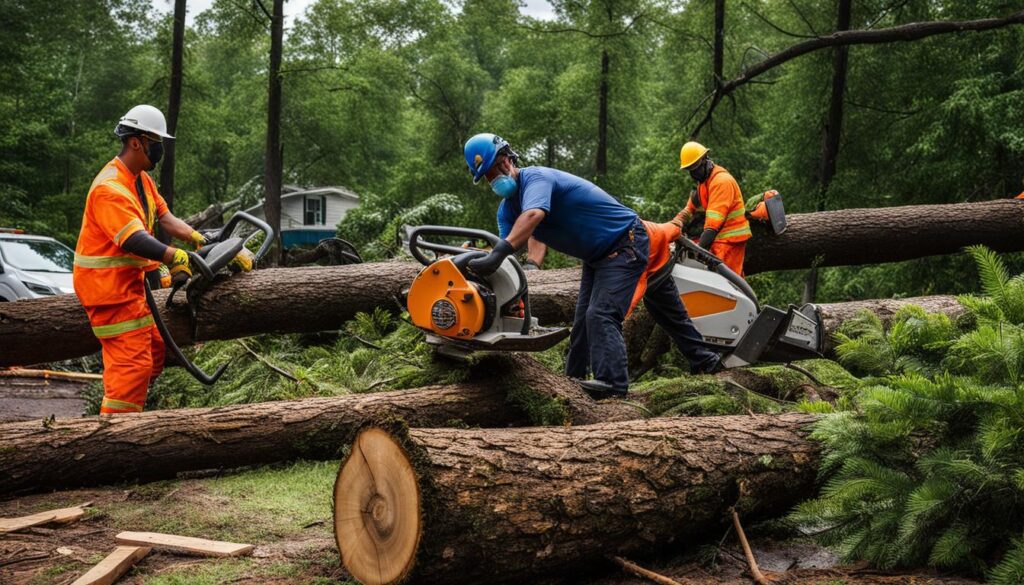As a keen observer of our nation’s flora, I’ve grown increasingly concerned with the silent decimation of ash trees caused by the emerald ash borer (EAB). This invasive species, barely the size of a dime, is leaving a path of destruction that demands immediate attention. My objective here is to arm you with the necessary insights for emerald ash borer prevention and EAB control, preserving the splendor of our precious ash trees. Effective pest management practices and a solid understanding of this invasive species are critical to protecting our ash tree population. Together, we can fortify our environment against this green menace.
Integrated ash tree protection methods start with local actions that have a broader impact. By adhering to guidelines and embracing proven treatments, we can halt the spread of the emerald ash borer and safeguard our communities. As we embark on this green defense strategy, let’s reflect on the power of collective, informed efforts against this ecological threat.
Key Takeaways
- Recognize the critical threat posed by the emerald ash borer and the importance of proactive prevention measures.
- Employ community-wide emerald ash borer prevention best practices, including strict management of firewood sources.
- Adopt systemic insecticides like imidacloprid for EAB control, following meticulous application guidelines.
- Understand the value of ash trees in our ecosystems and commit to ongoing ash tree protection efforts.
- Familiarize oneself with the latest advancements and recommendations in pest management to combat invasive species.
The Invasive Threat: Understanding the Emerald Ash Borer
My exploration into the perilous world of invasive species leads me to a rather alarming subject—the emerald ash borer. This beetle, while diminutive in size, carries an overwhelming influence on the ecosystems it invades.
What is the Emerald Ash Borer (EAB)?
The emerald ash borer’s scientific name, Agrilus planipennis, belies the devastation this insect can unleash upon ash tree populations. Known for its distinctive, metallic green hue, EAB has become synonymous with the destruction of ash trees in a range of environments.
Origins and Discovery of EAB in North America
The origin of the emerald ash borer tracks back to the woodlands of northeastern China and Korea, illustrating the extensive reach of this pest’s native territory. However, it is in North America, specifically Michigan, where I’ve observed EAB’s particularly destructive power. Its accidental introduction altered the landscape, signaling the start of a grim chapter for local ash species.
By examining the emerald ash borer range, I’ve witnessed the overwhelming ramifications—entire swathes of green and white ash trees have succumbed to the relentless breeding and feeding habits of this invasive beetle. In their larvae stage, EAB grubs gnaw intricate galleries just below the bark, wreaking havoc on the trees’ circulatory systems and setting the stage for a rapid and decisive ecological upheaval.
Identifying Signs of an Ash Tree Infestation
As I delve into the health of our ash trees, it becomes paramount to recognize the early signs of eab to curb ash tree infestation. Awareness of these symptoms not only helps in early detection but also in effective emerald ash borer treatment, mitigating extensive ash tree damage and limiting the spread of borer damage.
Identifying Symptoms of EAB Damage
In my observations, the initial symptoms of an infested ash tree often include a noticeable thinning of the canopy. This is followed by the death of branches and twigs starting from the top of the tree, a classic indication of the silent destruction that occurs beneath the bark. The effects are anemic, featuring progressively smaller leaves and a marked dwindling of the lush crown that ash trees are known for. This decline becomes increasingly apparent as the infestation worsens.
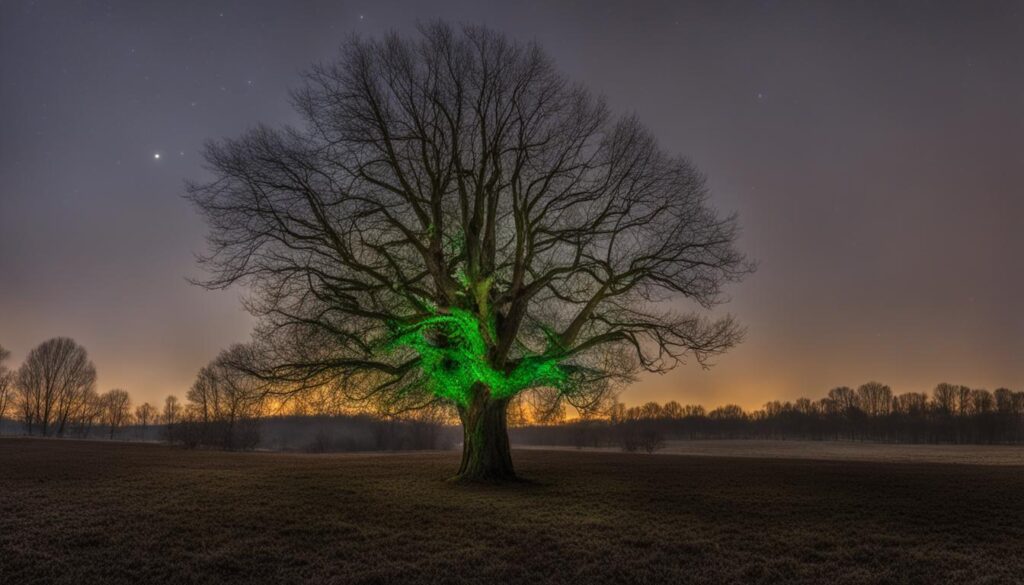

D-Shaped Exit Holes and Other Physical Signs
One unmistakable physical indicator of an EAB presence is the D-shaped exit holes, approximately 1/8 inch in diameter, that dot the bark. These signal the emergence of adult beetles and are a call to action. If I spot these signs from late May forward, it’s crucial that I initiate emerald ash borer treatment immediately. Procrastination at this stage means risking irreversible tree damage and a potential increase in the local borer population. Beyond the holes, trees may also exhibit vertical bark splits, exposing the S-shaped galleries, and an increase of woodpecker activity as they hunt for the larvae within.
By staying vigilant and recognizing these signs of EAB, I can take timely measures to intervene. An infested ash tree is not always a lost cause; accurate identification and prompt treatment can save these valued members of our ecosystem from this invasive menace.
The Devastation of Ash Tree Populations
In examining the ash tree destruction attributable to the emerald ash borer, my focus shifts to detailing the magnitude of this environmental crisis. What I’ve uncovered is a pattern of devastation that’s not only economically taxing but also ecologically catastrophic. The green ash borer, in its silent proliferation, stands as a poignant display of the vulnerabilities in our green infrastructure.
Economic and Ecological Impact
The stark reality of the green ash borer’s impact hits home when I discuss the financial implications for industries reliant on ash trees. Significant economic costs accrue from tree removal and the loss of ash wood, a resource otherwise destined for manufacturing various products. Beyond economics, the ecological repercussions are profound. With the ash tree beetles compromising the integrity of these trees, the resultant void in biodiversity and ecosystem stability presents an issue that transcends borders and resonates globally.
Demographic Affected Areas and Spread of Infestation
Turning the lens towards New York, a narrative of the emerald ash borer New York invasion emerges, painting a chilling picture of the ash tree pest’s reach. Quarantines, although a step in mitigating the spread, bear testament to the severity of the infestation and the widespread loss of ash trees. It’s a demographic challenge that infuses urgency into the discourse on preserving our arboreal heritage for future generations.
Strategies for Emerald Ash Borer Prevention
As I dive deeper into the intricacies of combating the emerald ash borer (EAB), it becomes clear that the solutions lie not just in treatments but in prevention. Understanding the risks and taking proactive steps are key. Sharing my findings on the emerald ash borer wiki has underscored the critical need for awareness and action among those of us who value our green canopies and the role they play in our ecosystems.
The Role of Firewood in EAB Spread
It’s astonishing how innocuous activities, like transporting firewood, can lead to widespread eab infestation. During my investigations, I’ve learned that these small actions can have devastating effects. The USDA’s guidelines are clear: by purchasing local firewood and burning it where I buy it, I can help prevent the transportation of these green tree beetles into new areas.
Insecticide Options for Ash Tree Protection
In my pursuit of ash tree protection, I’ve uncovered that systemic insecticides containing imidacloprid offer a shield of defense against the emerald bug. These pesticides, taken up by the tree’s roots, act as a barricade against the borer, stopping it before it can do more harm. Adhering to the label’s instructions is paramount for ensuring not only the efficacy of the treatment but also for maintaining the delicate balance of our environment.
Effective Control Measures for Infested Ash Trees
As someone deeply entrenched in the battle against the emerald ash borer, I can attest that once your ash trees are besieged by this invasive pest, swift and effective action is the key to survival and recovery. The primary weapons in our arsenal for emerald ash borer treatment are systemic insecticides, powerful allies like imidacloprid and emamectin benzoate. These can be applied in various forms: as soil drenches that soak into the ground to be sucked up by the roots, as trunk sprays that target the bark directly, or as direct injections into the trunk, which delivers the insecticide into the tree’s vascular system.
These treatments are more than just a reactionary measure; they serve as a prophylactic that can stave off new emerald ash borer attacks and, crucially, they can allow an ash tree suffering from borer damage to potentially regenerate. Acting at the first sign of trouble—when the tell-tale symptoms of an emerald ash borer infestation appear—is vital. If left unaddressed, the health of the tree will deteriorate in tandem with the growth of the borer population, increasing the difficulty of ash tree damage repair.
It’s essential to understand that emerald ash borer control is not merely about saving a single tree; it’s about defending our communities from widespread ecological and economic grief. That’s why, as soon as I detect or suspect an infestation, my immediate response is to consult with leafy veterans—certified arborists—and begin an insecticide regimen that could save not just a tree but a whole neighborhood’s arboreal character.
Emerald Ash Borer and Its Impact on Urban Landscaping
As I delve into the current state of urban landscaping, the threat posed by the ash tree pest, specifically the green emerald beetle, stands out as a significant challenge. The aesthetic and environmental benefits of ash trees in cityscapes cannot be overstated – they line our streets and beautify our parks, playing a critical role in urban green spaces. Unfortunately, these important community assets are under siege by the invasive EAB infestation, with potentially devastating consequences if left unchecked.
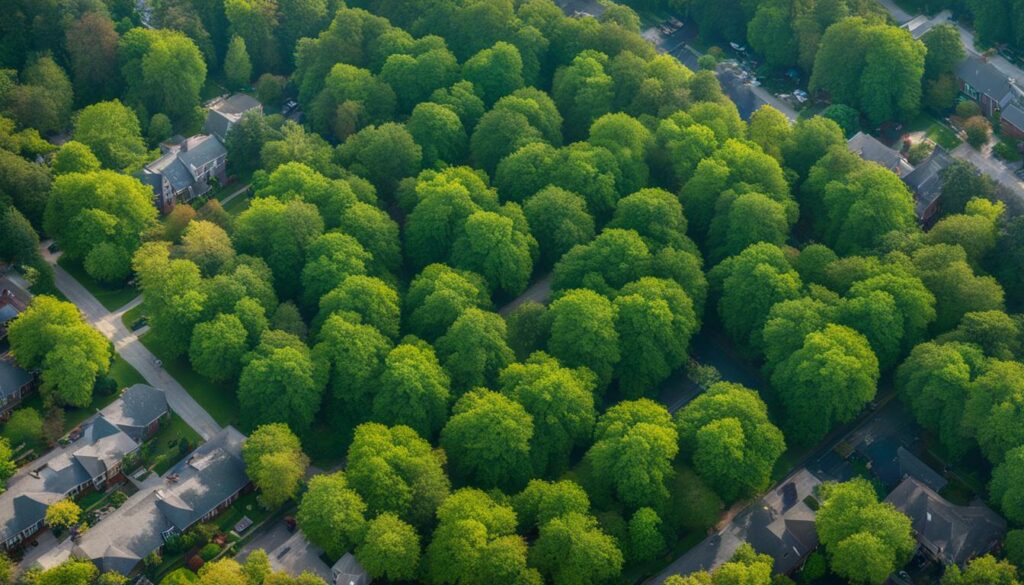

The damage inflicted by the ash tree pest extends beyond the obvious withering of individual trees; it undermines the ecological balance of urban areas. Ash trees help reduce pollution, offer shade that cools our cities, and provide a habitat for various wildlife. In my examination, the need for robust ash tree protection strategies is clear. Vigilant monitoring for signs of EAB, combined with prompt response measures, are essential to preserving the character and ecological health of our urban landscapes.
City planners and property owners alike must be proactive in dealing with the threat of EAB. My observation is that the green emerald beetle’s presence in an area can significantly depreciate property values and increase municipal maintenance costs. With community effort and the right approach to managing the issue – including the use of targeted insecticide treatments — we can protect our cities’ leafy canopies for the enjoyment and health of all residents.
In summary, the challenge posed by the emerald ash borer must be met with a united front to maintain the integrity and beauty of our urban landscaping. Embracing both prevention and cure, we can aim to mitigate the losses and perhaps even reverse the tide of this invasive species’ destruction. It is my hope, and indeed my goal, to see our ash trees thrive once again within our concrete jungles, safeguarding their value for generations to come.
Biological and Chemical Treatments Explained
As a professional intimately engaged in the battle against the emerald ash borer (EAB), Agrilus planipennis, I am constantly evaluating the effectiveness of various treatment options. My experience has taught me that a multifaceted approach is necessary to safeguard our ash trees from this devastating pest. In this section, we delve into the nuanced world of systemic insecticides and other treatments, highlighting their application and the balance we must strike between efficacy and environmental responsibility.
Systemic Insecticides and Their Application
Systemic insecticides represent a potent weapon in the arborist’s arsenal for combating EAB. Unlike superficial contact insecticides, systemic variants, such as emamectin benzoate, are designed to permeate the entirety of a tree’s system. Upon application, typically through trunk injection, the chemical is absorbed and distributed throughout the tree, creating a protective barrier that targets the feeding larvae and adult beetles alike. This method ensures that any emerald ash borer consuming the tree tissue is exposed to the insecticide, thus interrupting their lifecycle. The precise insecticide application is not only an art but a crucial science in preserving our ash populations.
Understanding the Benefits and Risks of Tree-Applied Treatments
The decisive action of systemic insecticides does not come without considerations. The chemical treatment for ash borer offers substantial benefits, providing long-lasting defense that can extend for multiple seasons, but they must be handled with care. Risks include the potential for unintended impacts on non-target species, particularly pollinators. As I advocate for the responsible stewardship of our urban canopies, I also promote the integration of biological control EAB measures. These methods, which can complement chemical treatments, involve deploying natural predators and implementing measures that reduce the emerald ash borer populations without disrupting the ecological equilibrium. Careful consideration and application of these treatments can help ensure the survival of ash trees and the continuation of their legacy in our landscapes.
Community and Regulatory Efforts to Combat EAB
In the fight against the emerald ash borer, collective action has shown to be a pivotal force. As I delve into the multifaceted approach our communities and regulatory agencies have taken, it’s evident that mitigating this crisis requires more than just individual effort—it’s a concerted push where every action counts. Stakeholders at various levels are spearheading initiatives designed to curtail the spread of this relentless pest and shield our cherished ash trees from its crippling grasp.
Regulations to Quarantine and Restrict Movement
Understanding the critical role movement plays in the proliferation of the emerald ash borer, stringent regulatory efforts ash borer are implemented to prevent further infestation. States like Washington exhibit proactive foresight by enforcing quarantine measures, restricting the transport of ash wood products beyond their current zones of infestation. These regulations serve not just as precautionary barriers but also as a testament to the firm commitment of regulatory bodies in safeguarding our ecosystem.
Public Awareness Campaigns and Hotlines
Furthermore, the war against EAB is fought on the front of awareness. Knowledge empowers; hence, widespread public education campaigns are crucial in amplifying emerald ash borer awareness. Through these initiatives, individuals learn to identify EAB signs and adopt responsible practices like proper firewood handling. The availability of hotlines, such as the USDA Emerald Ash Borer Hotline, offers immediate assistance and exemplifies the community efforts EAB mitigation depends upon. Ultimately, it’s the synergy of informed citizens, vigilant regulatory strategies, and expert pest management that underpins the hope for triumph over this invasive adversary.
FAQ
What is the Emerald Ash Borer (EAB)?
The Emerald Ash Borer (EAB) is an invasive green beetle that targets and destroys ash trees. Its scientific name is Agrilus planipennis.
Where is the Emerald Ash Borer native to?
The Emerald Ash Borer is native to northeastern Asia, mainly found in China and Korea before inadvertently making its way to North America.
How do I identify symptoms of Emerald Ash Borer damage?
Symptoms of EAB damage include thinning tree crowns, radial splits in the bark, D-shaped exit holes, and increased woodpecker activity on the ash trees.
What are the economic and ecological impacts of the Emerald Ash Borer infestation?
The infestation has caused the destruction of millions of ash trees, resulting in significant economic loss due to removal costs and the ecological impact of losing a native species that supports biodiversity.
Which areas are affected by the spread of the Emerald Ash Borer?
The EAB infestation has spread to numerous states in the U.S. and parts of Canada, with exact ranges consistently updated by environmental agencies.
How can the spread of Emerald Ash Borer be prevented?
Preventing the spread involves not moving firewood from one location to another, buying local or kiln-dried firewood, and employing preventive systemic insecticides like imidacloprid and emamectin benzoate as per label instructions.
What insecticide options are available for protecting ash trees?
Available options include systemic insecticides, which can be applied as soil drenches, trunk sprays, or injections, providing protection against existing and future EAB infestations.
Can infested ash trees be treated?
Yes, infested ash trees can be treated with systemic insecticides if the damage is not too advanced. It is crucial to act quickly upon detection of EAB infestation.
What is the impact of the Emerald Ash Borer on urban landscaping?
Emerald Ash Borers threaten urban landscaping by destroying ash trees which are a significant aspect of urban greenery, contributing to aesthetics, shade, and environmental quality.
How are systemic insecticides applied to manage Emerald Ash Borer infestations?
Systemic insecticides are applied through soil drenches, trunk sprays, or direct injections into the ash tree’s trunk and can provide season-long protection.
What are the benefits and risks associated with tree-applied insecticide treatments?
The benefits include long-term protection against EAB and reduced environmental impact compared to broad-spectrum spraying. Risks can involve potential harm to non-target species, particularly if not applied correctly.
What community and regulatory efforts are in place to combat the spread of Emerald Ash Borer?
Community and regulatory efforts include establishing quarantines, controlling wood movement, public awareness campaigns, and providing resources and hotlines for reporting and guidance.

